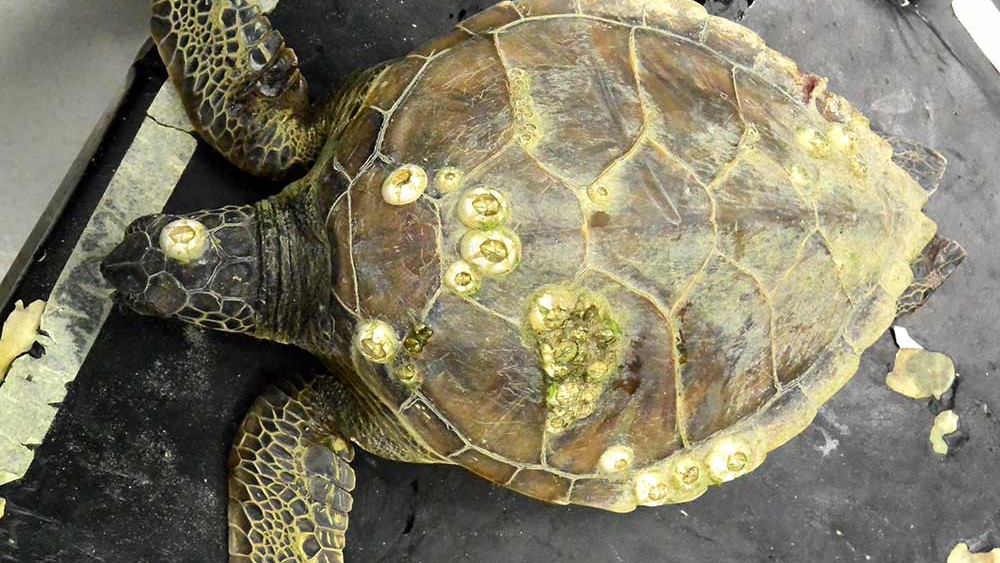Green (Chelonia mydas)
Stranding Location: Hilton Head Island, SC
Arrival Date: 04/09/2016
Weight: 2.99 kg (6.5 lb.)
Case History
A group of young girls biking the shores of Forest Beach on Hilton Head Island came across this little turtle lying on the beach. Since the turtle made no attempt to move when they approached, the girls knew something was wrong and called Shore Beach Service to file a report. Taylor Smith and Jerry Staub from Beach Service responded to the call and verified that the turtle was a threatened green sea turtle and although it appeared robust, it wasn’t moving and there were small spots of blood on the beach indicating the turtle was wounded. The next call was to Amber Keuhn, leader of the Hilton Head turtle team who is trained to handle sea turtle strandings. Amber transported the turtle halfway to Charleston to meet SCDNR staff, Liz Duermit, who then transported the turtle the rest of the way to the South Carolina Aquarium for medical treatment. We often say it takes a village to save sea turtles…this is a perfect example!
Treatment
At 8:30 pm on Saturday night, hospital staff was anxiously awaiting the arrival of this year’s ninth sea turtle patient. Upon admission the staff quickly got to work stabilizing the turtle. This involved giving subcutaneous (under the skin, SQ) fluids to help compensate for dehydration, giving injectable vitamins, antibiotics and taking blood. Overall the patient appeared fairly healthy, as s/he was bright and alert, had a strong heart rate of 30 bpm and was in overall good body condition. Blood work revealed low protein levels and Hetastarch was administered intravenously to help restore the body’s blood plasma. Physical examination revealed abrasion and lacerations to the front and rear flippers, which may have occurred during the stranding process. These wounds were flushed with sterile saline and treated topically with Triple Antibiotic Ointment. After all treatments were complete, Forest was dry docked on wet foam to recuperate and rest overnight.
Updates
10 April 2016: Radiographs are by far one of our best diagnostic tools when it comes to figuring out a cause of stranding. After reviewing Forest’s images it is apparent that the gastrointestinal tract (GI) is full of GI contents. The intestines appear distended which could be a sign of a blockage or impaction. It is not uncommon for green sea turtles to suffer from an impaction, which inhibits their ability to defecate, usually causing gas to build up in their GI and results in them floating on the surface of the water. This can sometimes be caused by the ingestion of artificial materials such as plastics.
11 April 2016:After being placed in one of the 600 gallon tanks in the STH it is evident that Forest is able to fully submerge and is commonly seen resting on the bottom of the tank. Since Forest has not defecated since admit, we are being proactive in treatment of a possible impaction. Today staff administered both an enema of mineral oil and gave a solution of MiraLax and Gastroview orally. Gastroview is a radiopaque contrast that allows us to monitor movement of the GI contents. The series of radiographs accumulated over the next several days will allow us to assess GI motility and better hone our course of treatment. For now our treatment plan consists of giving an antibiotic injection every three days coupled with SQ fluids, as well as taking daily radiographs.

19 April 2016: Forest is taking well to life in the Sea Turtle Hospital and is commonly seen gracefully swimming around the tank. We are happy to announce that s/he has defecated, which is a great sign that the GI tract is starting to function properly. Unfortunately, Forest is not in the clear yet as a partial impaction is still very possible. We will continue to keep tabs on the digestive system by repeating radiographs weekly. We have started offering some romaine lettuce which can be nibbled on throughout the day.
5 May 2016: Forest is doing much better! S/he has been processing food normally and it appears as if the blockage and distended GI are resolving themselves. We don’t want to overwhelm Forest’s digestion system so we are slowly increasing the amount being fed. Staff will continue to closely monitor food consumption. We will continue routine radiographs in order to detect any changes. In the meantime, we are trying to get this young green sea turtle interested in eating his/her vegetables, not just the more delectable fish! We have tried a variety of greens including romaine, green leaf, red leaf, kale, chard, collard green and green peppers. Hopefully, with this number of options, Forest will find something that is appetizing, and come around to eating his/her veggies!

24 May 2016: This young energetic green has finally come around to eating his/her veggies! In fact, this turtle is doing so well that we are starting to put the wheels in motion for a summer release!
18 June 2016: This beautiful green sea turtle is scheduled for pre-release blood work next week. We are hopeful that results will show s/he is ready for release. In the meantime Forest is living the luxurious life of good food and relaxation. Until it is time to be released, Forest is chowing down on generous portions of leafy greens and bite-size pieces of fish.

Release Date
June 30, 2016
Release Location
Isle of Palms County Park


